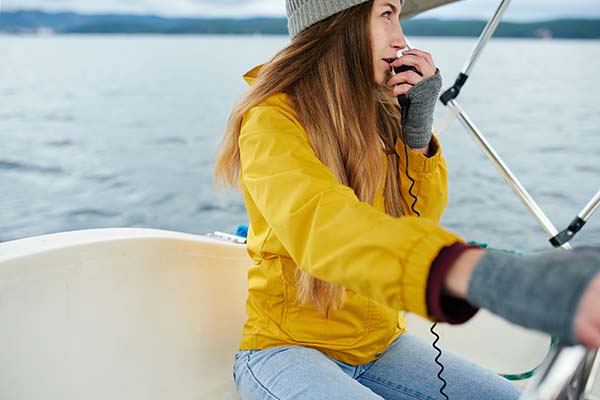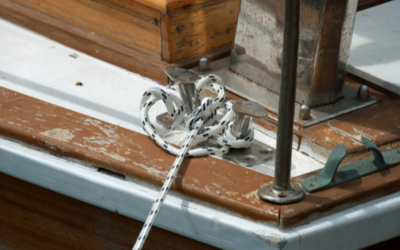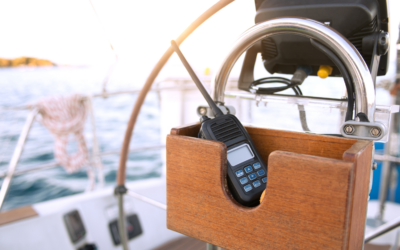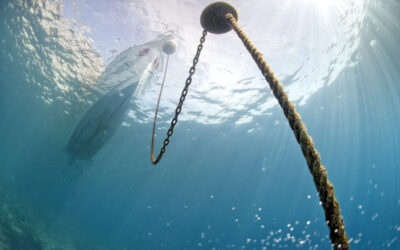Boating difficulties can quickly escalate to boating emergencies beyond your control. They can happen at any moment, anywhere, and to anyone. Even the most seasoned boater can run into engine trouble or weather issues. At the most basic level, all boaters should be able to signal for help. Being able to summon help quickly can make the difference between life and death in worst-case scenarios.
Four basic but very important and potentially life-saving items you want to be sure to keep on hand to call for help and survive any recreational boat emergency are:
- Flares (red for nighttime and orange for daytime)
- VHF Marine Radio
- Mobile Phone
- Emergency Position Indicating Radio Beacon (EPIRB)
Flares—The absolute minimum boating safety equipment that each recreational boat needs to have are are visual distress signals. They are the most effective at getting attention from other boaters when needed the most. If you see a distress signal from another boat, always respond immediately. The U.S. Coast Guard (USCG) recommends that you have and know how to use visual distress signals in the event of a boating emergency and even requires all recreational vehicles over 16 ft. to have a combination of day and night visual signal devices onboard as life-saving devices.
There are different types of visual distress signals for day and night emergencies. Day distress signals include an orange signal flag and orange smoke flares. The orange distress flag is an international symbol for distress on the water. Placing an orange distress flag as high as possible on your vessel allows other boaters to see your call for help from miles away.
The orange smoke flares are more effective than the standard red flares for daytime use because the orange smoke lingers in the air, providing an extended period of time for other boaters to see your call for help. Since the smoke will eventually dissipate, it is imperative that you use this signal method when you have a good chance of being spotted by incoming air or vessel traffic.
If an emergency happens at night, the most common and effective night-use distress signals are SOS electric signal lights and red signal flares. The electric signal lights are effective in emergencies because they can display bright signal lighting for an extended period of time. These electric lights can be placed on your vessel in the same way that you would display an orange distress flag. When positioned correctly, an electric light signal can display a call for help for much longer than any flare.
The red flares when shot up into the sky, last for about 3 minutes and work best when rescue is nearby. Both red and orange flares used from the hand-held launching device can be seen from a great distance, alerting other boaters.
VHF Marine Radios—The other important emergency equipment to have onboard is a VHF (very high frequency) marine radio. This piece of equipment has become increasingly popular with boaters. They have channels that are reserved for distress calls and are monitored continuously by the USCG. Benefits to investing in one onboard include:
- easy to use;
- are more effective for marine communications than CB radios or mobile phones;
- have more consistent reception than mobile phones;
- no license is needed when used in recreational boats;
- can withstand rough weather;
- boat-mounted radios are wired to the boat’s battery; and
- the source of a VHF signal can even find the distressed boater in a fog.
Emergency calls should be made on Channel 16 of a VHF marine radio. This is a dedicated distress channel and should only be used for emergencies to contact another boat or station. After the initial contact, the conversation needs to move to a non-emergency channel such as 68 or 69. Be aware that there are penalties for misuse of the radio, including improper use of VHF Channel 16, so do not use the emergency channel for any other purpose than a life-threatening emergency.
When issuing a MAYDAY call on Channel 16, you need to know that the distance for sending and receiving messages is limited by the height of the antenna and the power of your VHF marine radio. Use the one-watt setting except in an emergency or if your signal is too weak to be received clearly.
Here is how to issue a MAYDAY call on Channel 16 of your VHF radio:
- Transmit “MAYDAY, MAYDAY, MAYDAY.”
- Say, “This is (name of boat three times, call letters once).”
- Repeat once more, “MAYDAY,” and your vessel’s name.
- Report your location.
- Report the nature of your emergency.
- Report the kind of assistance needed.
- Report the number of people on board and the condition of any injured.
- Describe the vessel and its seaworthiness.
- Wait for a response. If there is none, repeat the message.
Mobile Phone—Cell phones can be useful for contacting local law enforcement agencies, but should never be used instead of a VHF radio due to its limitations. However, you should still consider your cell phone as part of your standard boating gear. Keep a list of appropriate phone numbers on board and just as you would on land for emergencies, use your cell phone to call 911 or another water rescue authority in your area.
Emergency Position Indicating Radio Beacon (EPIRB)—An EPIRB is another way boaters and mariners use to send a signal they are in distress by providing Search and Rescue with your location via GPS data or a global satellite system. The EPIRB transmits a 406-MHz distress signal that contains a unique 15-digit identification number to a global satellite system. This will then pull up your beacon registration and show not only who the beacon belongs to but provides additional emergency contact information. This positional data is provided to the Rescue Coordination Center closest to your location.
EPIRBs are typically installed on boats and can be operated automatically or manually after an incident. In most countries, EPIRBs are mandated to be used in all commercial shipping. However, EPIRBs are also used on yachts, boats, and other recreational vessels.
Once placed in the water, EPIRBs will operate by self-activating and floating upright in a transmitting position.
One other location device boaters can use is called Personal Location Beacons (PLB) that performs similarly to an EPIRB. PLBs must be manually activated and be held out of the water to function properly even though they are water-proof.
Being prepared for any emergency is key to safe boating trips and part of that preparation is to equip your boat or recreational vessel with the proper mix of visual signal devices and make sure to carry extra. It’s also worth noting to pay attention to the expiration date of your devices and store them in a dry compartment when not in use, so they will be ready if you ever need them.



